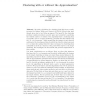Free Online Productivity Tools
i2Speak
i2Symbol
i2OCR
iTex2Img
iWeb2Print
iWeb2Shot
i2Type
iPdf2Split
iPdf2Merge
i2Bopomofo
i2Arabic
i2Style
i2Image
i2PDF
iLatex2Rtf
Sci2ools
COCOON
2010
Springer
2010
Springer
Clustering with or without the Approximation
We study algorithms for clustering data that were recently proposed by Balcan, Blum and Gupta in SODA’09 [4] and that have already given rise to two follow-up papers. The input for the clustering problem consists of points in a metric space and a number k, specifying the desired number of clusters. The algorithms find a clustering that is provably close to a target clustering, provided that the instance has the “(1 + α, ε)-property”, which means that the instance is such that all solutions to the k-median problem for which the objective value is at most (1 + α) times the optimal objective value correspond to clusterings that misclassify at most an ε fraction of the points with respect to the target clustering. We investigate the theoretical and practical implications of their results. Our main contributions are as follows. First, we show that instances that have the (1+α, ε)-property and for which, additionally, the clusters in the target clustering are large, are easier t...
| Added | 19 Jul 2010 |
| Updated | 19 Jul 2010 |
| Type | Conference |
| Year | 2010 |
| Where | COCOON |
| Authors | Frans Schalekamp, Michael Yu, Anke van Zuylen |
Comments (0)

